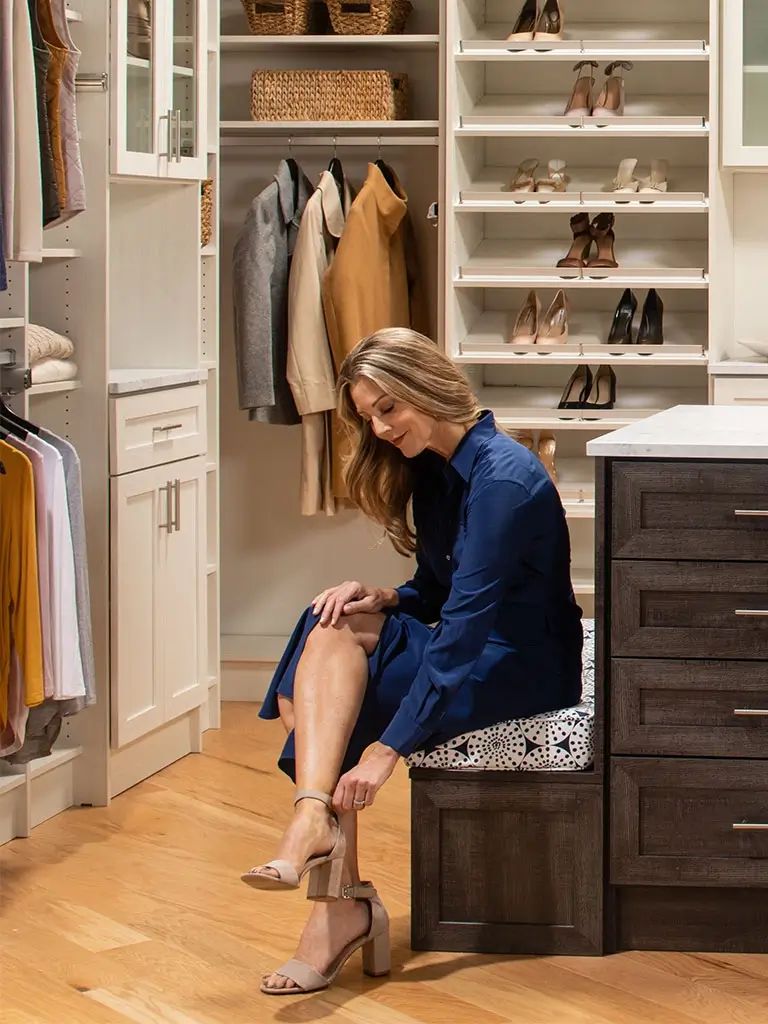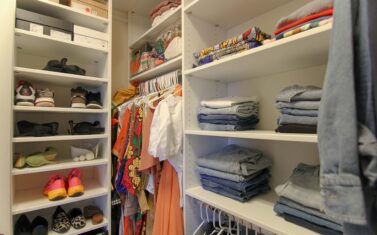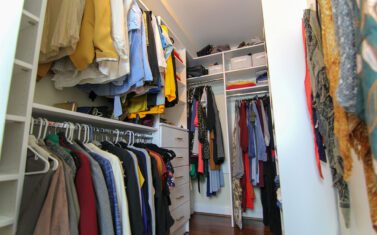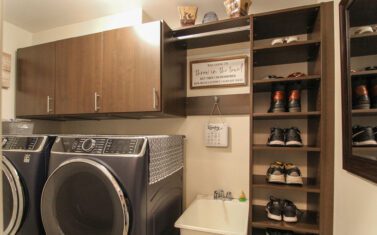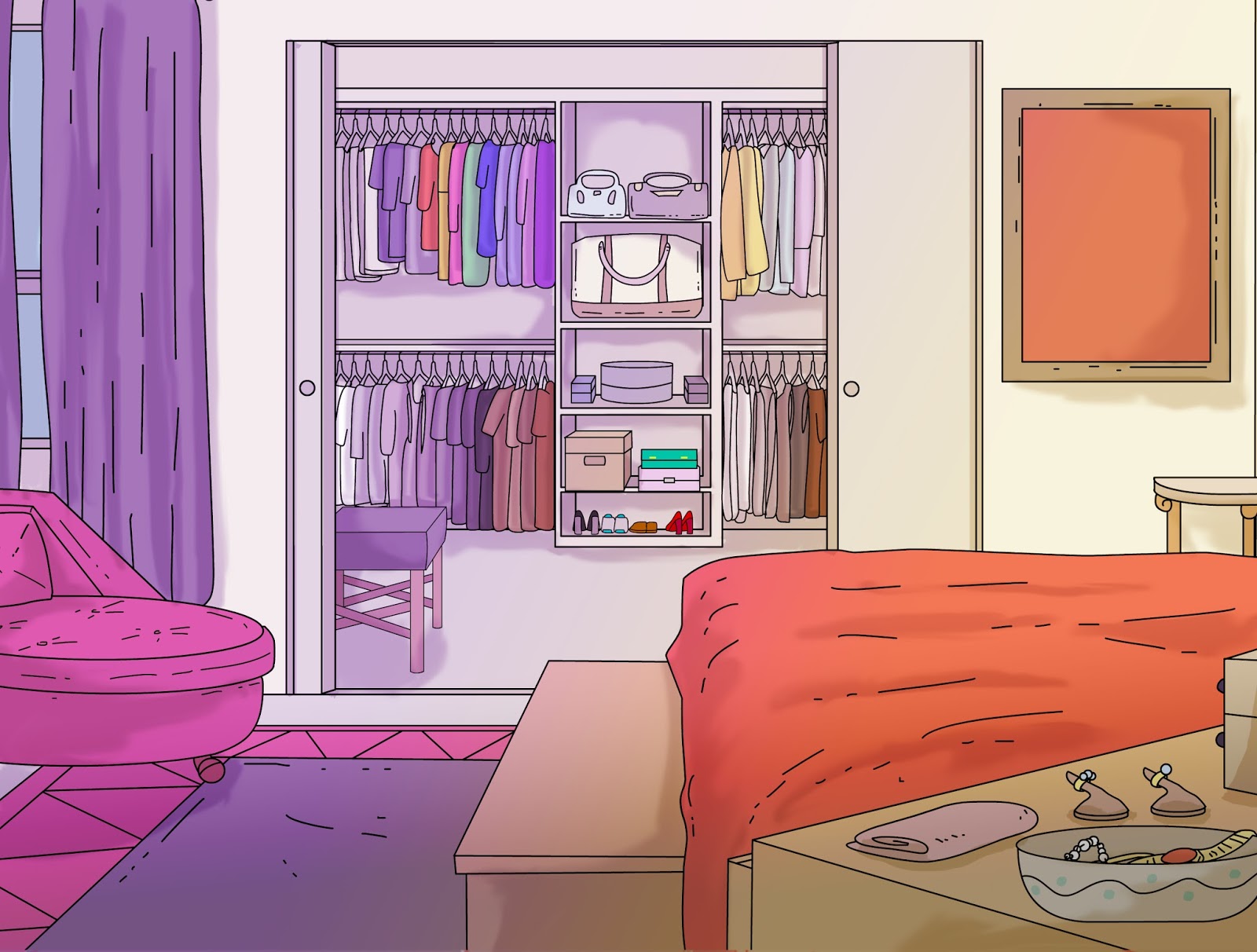
The Ultimate Guide to Custom Closet Organization Ideas
12 minute read, by Closet America, on Dec 6, 2016
A cluttered closet can turn a simple morning routine into a struggle. Check out our ultimate guide to designing and organizing an effective storage system with cool custom closet ideas.
I’ve worked with tons of slightly panicked clients who want to redesign their reach-in or walk-in but don’t know where to start. As a Closet America designer, I firmly believe the process should be fun, not overwhelming, but there’s definitely a lot to think about.
To get some of your own ideas flowing, here are my suggestions for solving a few common design challenges. And when you’re ready to take the next step, you’re welcome to get in touch for a free consultation.
How to Choose Closet Features for an Effective Use of Space
With so many product options, it can be tricky to figure out what you actually need in your closet. To make sure features that seem cool now don’t wind up collecting dust, I’d suggest keeping these factors in mind:
What Will Make Your Life Easier?

Storage needs vary from person to person, so start by taking inventory of what you have in your closet—the more detailed, the better. How many pairs of shoes do you actually own? How many t-shirts have been hiding in the back of your sock drawer?
Once you have a complete list, ask the all-telling question: “what will make my life easier?” For example, if you have a lot of business wear and find it a hassle to plan outfits every morning, a valet rod could be life-changing. If your sweater collection is continually growing, the extra drawers that a closet island offers might be the way to go.
Every feature that you select should not only serve a purpose but solve a problem. If you can’t envision how it will make your current routine easier, give it a pass.
What Closet Accessories Deserve a Spot in Every Closet?

That being said, there are a few tried and true accessories that the vast majority of my clients find helpful. You might be the exception to the rule, but I’d suggest at least considering these options:
-
Valet Rods. Having a valet rod in your closet is like having an extra hand right when you need it. From planning outfits to setting aside dry cleaning or separating clothes for a trip, valet rods are pretty versatile.
-
Hooks also provide extra assistance by giving you space for items that need a temporary home. But they can do double-duty by providing storage for accessories like necklaces, belts, handbags, and scarves. And as a bonus, they hardly take up any space.
-
Tilt-out Laundry Hampers. If I surveyed all my past clients and asked what item used to take up the most closet space, laundry baskets would be near the top. They’re necessary but bulky, which means it’s usually worth losing a little cabinet space in favor of a built-in hamper. Your closet will feel bigger (and look tidier). Most tilt-out hampers have removable bags, so it’s still easy for you to bundle everything up and take it to the washing machine.
Highlight Your Favorite Categories
I firmly believe that your closet should feel like a showroom for your favorite items. If belts or ties are what you love most, pull-out belt or tie racks are a sound investment. If shoes are your thing, it’s definitely worthwhile to install a wall of shelving just for shoes, with recessed LED lighting to display your collection to advantage. Your closet is full of items that tell stories about who you are. Think about what excites you, and pick features that will help highlight this category.
Additional Reading:
How to Create More Room in Your Closet

I’ve noticed that no matter how large the walk-in, belongings still have the ability to spread out over every square inch of available space. If you’re trying to find more room in a closet that’s already cramped, here are a few things that can help:
Utilize Slide-Out Storage
Slide-out closet accessories are great for creating space. Our slide-out tie rack, for example, can store up to 18 ties but is less than two inches wide. When it’s installed on your shelving unit, it’s barely noticeable—but much more efficient than trying to store that same tie collection in, say, a divided drawer. This holds true for belt and scarf racks, too. And even larger features, like fold-out ironing boards, can save space compared to their less compact counterparts.
There’s also a psychological aspect: a cluttered environment is one of the reasons that many of my clients feel like they don’t have room, and slide-out features help minimize the clutter and keep your space looking tidy.
Add More Shelves
Lots of people leave their closet shelving in “default” position: spaced evenly from top to bottom. I’d suggest adjusting your shelves so that each one provides just enough clearance to be easy to use without leaving any extra space. Once all shelves are rearranged, you should find that there is enough room to add another shelf (or two, if you’re really lucky).
The same rule applies to shoe shelves, but be sure to measure shelf clearance by using the tallest pair of shoes you’ll be storing so that you don’t run into trouble when you try to remove your favorite pair of heels.
Create a Secondary Storage Space
It’s great to be able to admire your entire wardrobe all in one place, but you probably have plenty of items that don’t actually need to live in your bedroom closet. Most people don’t use formal wear or evening wear on a daily (or even weekly) basis, for instance, so try moving these items out to free up additional space for jeans, tees, or business wear. Costumes, matching parent and child outfits, and out-of-season clothing like tank tops or skiwear are also great candidates for a secondary storage space.
But anything you move should still be stored in an organized manner—otherwise you won’t be able to find it once you actually need it. Some of my clients like to renovate hall or guest room closets at the same time that they customize their bedroom closets, and you might also consider installing custom cabinets in your garage or basement if you still need more space.

Purge the Clutter
You knew this tip was coming! One of the easiest and most obvious ways to create more room is to get rid of items no longer in rotation. Clothes that you haven’t worn in over a year, that no longer fit, or that no longer match your style should be the first to go. (I’ve found that most people wear about half of what’s actually in their closets.)
Parting can be tough, especially because of the emotional attachment we often develop with our clothing. But the more you purge now, the more space you’ll have for new items. Once you decide what needs to go, just make sure to get it out of the house within 24 hours—before you change your mind.
Additional Reading:
How to Store Accessories in Your Closet
Shoes, jewelry, purses, hats—accessories have a habit of swallowing up your entire closet if you let them. But the right storage solutions can keep your collection under control.
How to Store Jewelry

Separate Everything
In my experience, compartmentalized drawers are the best way to store your jewelry since you want separate cubbies for everything. You can use hooks or jewelry trees in a pinch, but these are sometimes designed with necklaces in mind and may not work as well for other pieces.
If you can’t avoid blending your jewelry together, at least be sure to keep your silver separate. Silver can tarnish if it continually interacts with oxygen in the air, so storing it in a container with a cover, or in a drawer, keeps it in better shape.
Choose Your Material Wisely
I’d recommend a jewelry organizer lined in black velvet for two reasons: The velvet is soft and non-abrasive, which helps preserve the beauty of your pieces, and having a dark contrast allows you to see and find delicate pieces (and earring backs) more easily.
Black against gold, silver, or platinum also makes your collection pop—and who doesn’t want to feel like they’re in an upscale jewelry store every time they get dressed?
Categorize and Color Code
If you’ve got an especially large jewelry collection, categorizing and color-coding will help you keep track of everything. Start with the basics: create major categories such as earrings, necklaces, and bracelets. Depending on how much jewelry you own, it may also make sense to create categories for real versus costume jewelry. Each group should then have a separate area of storage. This might mean a separate part of your jewelry tray or even a separate drawer.
Once you’ve got general categories set up, color code within each group. This can be as simple as putting all of your gold, silver, and rose gold metals into their own separate sections. Or, if you own a lot of colorful pieces, keeping your reds, oranges and yellows stored in one area and blues, greens, and purples in another will make it easier for you to quickly pick accessories based on the color of your outfit.
How to Store Shoes

Traditional Shoe Storage Methods
If you’re building a custom closet, I’d typically recommend storing shoes on angled shelves with shoe fences. An angled shelf gives you the ability to easily see each pair of shoes, which makes planning outfits much easier. This option also creates a very elegant, boutique-style display for your collection.
If clients don’t have the space to accommodate shoe shelves, I often suggest custom shoe drawers instead. Though it might seem counterintuitive to put shoes in a drawer, this option keeps shoes off the floor of your closet, making the area feel bigger. The major pitfall here is simply making sure you keep your shoes organized: you don’t want your drawer to become a bottomless pit of tangled footwear. If you have a large collection, you’ll probably want to spring for several drawers, one for each category of shoe.
How Do I Store My Boots?
Since the shafts of most boots are higher than the average pair of heels, storing them can be tricky. If you’re using shelves, make sure that your shelving system has adjustable pegs. This way, when the weather cools and your boots are in rotation, you have the ability to raise the shelves to ensure your boots fit.
If you have large drawers, boots can work here as well. You generally need a width of about 23-24 inches to accommodate taller boots, and as long as you lay the boots on top of each other, in alternate directions, you should be able to accommodate several pairs in one drawer.
What Are Some Other Shoe Storage Alternatives?
-
Use a basket. Many professional organizers like to use slide-out baskets for shoe storage. Sneakers, flats, sandals, and other casual non-heeled shoes are all great options for this and take up far less space in a basket than on a floor-standing rack. While the number and size of the baskets you use will depend on the style of your shoes, a 12-inch by 12-inch basket, for example, should be able to accommodate 6-8 pairs of flats or sandals.
-
Use your linen closet. If you’re willing to sacrifices some linens for your prized shoe collection, this is another great option (especially if you’re trying to free up space in your master closet). Since linen closets already have built-in shelves, it’s very easy to slide your shoes in and line them up. The linens that you take out can be stored in a guest closet or in baskets in your bathroom cabinets.
How to Store Hats and Purses

Display Them!
Hats and purses are a storage challenge because they don’t come in just one shape and aren’t easy to fold down. But they’re fun accessories, usually purchased to be shown off—and that shouldn’t stop when you get home.
Make your closet into a boutique and display your purses and hats like a store would by designating one or two middle or upper shelves just for them. For purses that don’t have much structure, you can buy purse pillows or stuff them with a few sheets of tissue paper so that they stand up and maintain their form. You can also add LED lighting to these shelves to highlight your display.
Invest in Hat Boxes
If you have especially fancy hats, investing in a couple of hat boxes will allow you to properly store them. These boxes are pretty spacious, so you should be able to fit several pieces into one box without damaging them. Since hat boxes are round and come in a lot of fun colors, they make great décor pieces and can be placed toward the back of your shelves or on top of your storage system without adding visual clutter.
Color Code and Stack Your Baseball Caps
People with a passion for baseball caps often have sizeable collections, and it can be challenging to display every single hat. Since you probably choose caps to wear based on their color, I’d suggest stacking similar colors together and arranging the stacks horizontally—one right in front of the other. From there, your hats can either sit on a shelf in the closet without taking up too much space, or they can go into a storage bin that can easily slide out when you need it.
Use Wall Hooks
Depending on the size of your hat or purse collection, you can also create your very own wall art by using hooks to display everything. While hooks can be added almost anywhere, you’ll want to keep them evenly spaced for a large collection, creating a grid. This ensures that your arrangement looks purposeful instead of random.
I’d also suggest that you use single hooks rather than double hooks: while double hooks can technically hold two items, hats and purses are large enough that it’s difficult to fit two on one hook. Also, don’t forget to the empty contents from each purse before hanging, to avoid putting unnecessary weight on the hooks.
How to Organize Your Custom Closet (and Keep it Organized) After Installation
Plenty of people install custom closets as a way to reduce clutter, but what happens after installation? It’s something clients don’t always consider, but a few organizing strategies will keep your space looking beautiful.
Sort and Categorize

My first suggestion is to sort and categorize all of your clothing. Each category should live in a separate section of your closet. The exact division depends on what you own, of course, but here are a few common ways to break your items up:
-
By clothing type: tops, pants, skirts, shorts, dresses, suits
-
According to sleeve or hem length:
-
Shirts: strapless, sleeveless, short sleeve, long sleeve
-
Pants: cropped, full length
-
Skirts: mini, knee length, midi, maxi
-
-
Fabric: cotton, silk, polyester, wool
-
Function: casual, work, formal
-
Season: spring/summer, fall/winter
As long as each type stays in its own general area of your closet, you’re well on your way to a tidy space.
Arrange Your Clothing in a Way That Makes Sense
I also encourage people to think about their daily lifestyles. A closet arrangement that matches your routine is a lot easier to maintain. For instance, if you work out four or five days a week, drawers or shelves that hold your workout gear should be in the middle of your unit and toward the front of your closet. This lets you easily get to everything (and easily put it back) each day.
There is no secret, one-size-fits-all approach here—it’s truly about your habits. If you’re not even sure that you have a routine, try keeping track of every outfit you wear over the course of 2-3 weeks and arranging the contents of your closet around that list.
Recognize Your Clutter Indicators

As you’re organizing your new space, think back to what caused clutter in the past. If you’re finding that t-shirts end up in piles because you don’t have time to fold them, for example, it may be a signal that it is better to hang them.
In my experience, common clutter-causers include handbags (if you’re constantly switching them out), clothes that you’ve worn once and taken off but are planning to wear again, and fresh dry cleaning items.
In all of these situations, a routine to manage the transition makes it far less likely that clutter will occur. This might mean always hanging your dry cleaning from valet rods or having a dedicated shelf for items you’re planning to wear again. If you swap purses often, it might just mean dumping everything out of one purse and putting it away before placing all of your items into a new purse. Basically, you want a system that’s easy to follow and ensures you don’t end up with heaps of stray belongings on the floor.
Get Everything off Counters and Dressers
Clutter always seems to find its way to counter tops. To keep flat surfaces as clear as possible, I’d suggest designated bins and containers for smaller items, like old receipts, spare change, lip balm, or breath mints. These containers should be kept in eyesight so that you remember to use them, but I’d avoid putting them on counters since they sometimes just add to the clutter. Instead, consider a designated shelf with a couple of small bins or baskets, or even a drawer where the contents of your pockets always go as you get undressed.
It can still be a struggle on busy mornings, but planning ahead and paying attention to your habits will help your closet stay beautiful.
